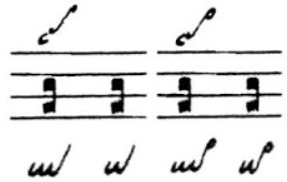I posted this question on Wikipedia a year ago, with no answers. These two musical signs look eerily similar.
The Baroque Schleifer or slide (see Wikipedia page):
The quilisma in Gregorian chant (see French Wikipedia page):
Coincidentally, their performance is nearly identical. The Gregorian quilisma is now known to have been originally sung as a quick sliding glissando or portamento towards a higher note, or, equivalently, as a quick rising grace or passing tone towards that note.
In the picture above, the two signs above the staff are the quilisma as it appears in ninth-century Laon/Lorraine/Metz notation of Gregorian chant, where it is depicted as a medieval question mark ('?' upside-down) to indicate the rising of the voice.
The four signs below the staff are the quilisma in ninth- and tenth-century St. Gall notation. I highly suspect this is the ancestor of the Schleifer sign, on account of
- identical shape,
- identical performance, and
- St. Gall notation being regional to Germany and Switzerland at the end of the first millennium.
Could this be a pure coincidence? Is it possible to conclude from any evidence a true ancestral relationship here?
Do we have samples of similar signs used in music between 1100 and 1600 that could suggest a continuity of the symbols' application?






